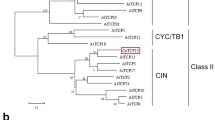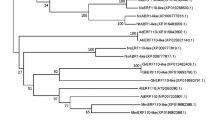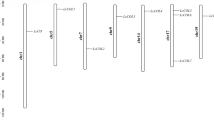Abstract
E2F transcription factors play key roles in plant growth and development by regulating the cell cycle. In this study, ClE2F1 was isolated from Chrysanthemum lavandulifolium. This gene encodes a 452-amino-acid protein that contains a DNA-binding domain, marked box domain, pRBR-binding domain, and a nuclear localization signal. Phylogenetic analysis showed that ClE2F1 was most closely related to Arabidopsis thaliana AtE2Fa, AtE2Fb, and AtE2Fc. Transient expression experiments demonstrated that the ClE2F1 protein localizes to the nucleus. Yeast one-hybrid assays showed that ClE2F1 promotes transcriptional activation. The morphology of the OX-6, OX-7, and OX-10 transgenic and wild-type lines was investigated. Plant height, leaf length and width, inflorescence diameter, disc flower diameter, the number of tabulate florets, and ligulate floret length were greater in the OX-6, OX-7, and OX-10 lines than in wild-type plants. Microscopic observation revealed a higher number of cells per unit area but a smaller cell area in the OX-6, OX-7, and OX-10 lines than those in wild-type plants. In addition, the relative expression of cell cycle-associated genes in the OX-6, OX-10, and wild-type plants revealed that the ClPCNA3, ClRNR, ClASF, ClDPa, ClCDKA, and ClCYCD transcript levels were up-regulated in the OX-6 and OX-10 plants, whereas ClRBR and ClKRP5 expression was down-regulated.





Similar content being viewed by others
References
Apostolova MD, Ivanova IA, Dagnino C, D’Souza SJ, Dagnino L (2002) Active nuclear import and export pathways regulate E2F-5 subcellular localization. J Biol Chem 277:34471–34479
Attwooll C, Lazzerini Denchi E, Helin K (2004) The E2F family: specific functions and overlapping interests. EMBO J 23(24):4709–4716
Bracken AP, Ciro M, Cocito A, Helin K (2004) E2F target genes: unraveling the biology. Trends Biochem Sci 29:409–417
Cam H, Dynlacht BD (2003) Emerging roles for E2F: beyond the G1/S transition and DNA replication. Cancer Cell 3:311–316
Cheng Y, Cao L, Wang S, Li Y, Shi X, Liu H, Li L, Zhang Z, Fowke LC, Wang H, Zhou Y (2013) Down-regulation of multiple CDK inhibitor ICK/KRP genes up-regulates E2F pathway and increases cell proliferation, organ and seed sizes in Arabidopsis. Plant J 75:642–655
Cockcroft CE, den Boer BG, Healy JM, Murray JA (2000) Cyclin D control of growth rate in plants. Nature 405:575–579
Czerednik A, Busscher M, Angenent GC, de Maagd RA (2015) The cell size distribution of tomato fruit can be changed by overexpression of CDKA1. Plant Biotechnol J 13:259–268
De Veylder L et al (2001) Functional analysis of cyclin-dependent kinase inhibitors of Arabidopsis. Plant Cell 13:1653–1668
De Veylder L et al (2002) Control of proliferation, endoreduplication and differentiation by the Arabidopsis E2Fa-DPa transcription factor. EMBO J 21:1360–1368
DeGregori J, Johnson DG (2006) Distinct and overlapping roles for E2F family members in transcription, proliferation and apoptosis. Curr Mol Med 6:739–748
Di Stefano L, Jensen MR, Helin K (2003) E2F7, a novel E2F featuring DP-independent repression of a subset of E2F-regulated genes. EMBO J 22(23):6289–6298
Dimova DK, Dyson NJ (2005) The E2F transcriptional network: old acquaintances with new faces. Oncogene 24:2810–2826
Dyson N (1998) The regulation of E2F by pRB-family proteins. Genes Dev 12:2245–2262
Egelkrout EM, Mariconti L, Settlage SB, Cella R, Robertson D, Hanley-Bowdoin L (2002) Two E2F elements regulate the proliferating cell nuclear antigen promoter differently during leaf development. Plant Cell 14:3225–3236
Francis D (2011) A commentary on the G(2)/M transition of the plant cell cycle. Ann Bot 107:1065–1070
Gao R, Wang H, Dong B, Yang X, Chen S, Jiang J, Zhang Z, Liu C, Zhao N, Chen F (2016) Morphological, genome and gene expression changes in newly induced autopolyploid Chrysanthemum lavandulifolium (Fisch. Ex Trautv.) Makino. Int J Mol Sci 17:1690–1702
Humbert PO, Rogers C, Ganiatsas S, Landsberg RL, Trimarchi JM, Dandapani S, Brugnara C, Erdman S, Schrenzel M, Bronson RT, Lees JA (2000) E2F4 is essential for normal erythrocyte maturation and neonatal viability. Mol Cell 6:281–291
Imajuku Y, Ohashi Y, Aoyama T, Goto K, Oka A (2001) An upstream region of the Arabidopsis thaliana CDKA;1 (CDC2aAt) gene directs transcription during trichome development. Plant Mol Biol 46:205–213
Inze D (2005) Green light for the cell cycle. EMBO J 24:657–662
de Jager SM, Menges M, Bauer UM, Murray JAH (2001) Arabidopsis E2F1 binds a sequence present in the promoter of S-phase-regulated gene AtCDC6 and is a member of a multigene family with differential activities. Plant Mol Biol 47:555–568
Judah D, Chang WY, Dagnino L (2010) EBP1 is a novel E2F target gene regulated by transforming growth factor-β. PLoS One 5:pone.0013941
Kong LJ, Orozco BM, Roe JL, Nagar S, Ou S, Feiler HS, Durfee T, Miller AB, Gruissem W, Robertson D, Hanley-Bowdoin L (2000) A geminivirus replication protein interacts with the retinoblastoma protein through a novel domain to determine symptoms and tissue specificity of infection in plants. EMBO J 19:3485–3495
Kosugi S, Ohashi Y (2002a) E2Ls, E2F-like repressors of Arabidopsis that bind to E2F sites in a monomeric form. J Biol Chem 277:16553–16558
Kosugi S, Ohashi Y (2002b) Interaction of the Arabidopsis E2F and DP proteins confers their concomitant nuclear translocation and transactivation. Plant Physiol 128:833–843
Kosugi S, Ohashi Y (2003) Constitutive E2F expression in tobacco plants exhibits altered cell cycle control and morphological change in a cell type-specific manner. Plant Physiol 132:2012–2022
del Pozo JC, Diaz-Trivino S, Cisneros N, Gutierrez C (2006) The balance between cell division and endoreplication depends on E2FC-DPB, transcription factors regulated by the ubiquitin-SCFSKP2A pathway in Arabidopsis. Plant Cell 18:2224–2235
Lario LD, Ramirez-Parra E, Gutierrez C, Spampinato CP, Casati P (2013) Anti-silencing function1 proteins are involved in ultraviolet-induced DNA damage repair and are cell cycle regulated by E2F transcription factors in Arabidopsis. Plant Physiol 162:1164–1177
Li P, Song A, Gao C, Jiang J, Chen S, Fang W, Zhang F, Chen F (2015) The over-expression of a chrysanthemum WRKY transcription factor enhances aphid resistance. Plant Physiol Biochem 95:26–34
Lindeman GJ, Aubatz S, Livingston D, Insberg D (1997) The subcellular localization of E2F-4 is cell-cycle dependent. Proc Natl Acad Sci 94:5095–5100
Luisa M, Barbara P, Rita C (2002) The E2F family of transcription factors from Arabidopsis thaliana. Novel and conserved components of the retinoblastoma/E2F pathway in plants. J Biol Chem 277:9911–9919
Macaluso M, Cinti C, Russo G, Russo A, Giordano A (2003) pRb2/p130-E2F4/5-HDAC1-SUV39H1-p300 and pRb2/p130-E2F4/5-HDAC1-SUV39H1-DNMT1 multimolecular complexes mediate the transcription of estrogen receptor-alpha in breast cancer. Oncogene 22:3511–3517
Magyar Z, de Veylder L, Atanassova A, Bakó L, Inzé D, Bögre L (2005) The role of the Arabidopsis E2FB transcription factor in regulating auxin-dependent cell division. Plant Cell 17:2527–2541
Magyar Z, Horváth B, Khan S, Mohammed B, Henriques R, de Veylder L, Bakó L, Scheres B, Bögre L (2012) Arabidopsis E2FA stimulates proliferation and endocycle separately through RBR-bound and RBR-free complexes. EMBO J 31:1480–1493
Mariconti L, Pellegrini B, Cantoni R, Stevens R, Bergounioux C, Cella R, Albani D (2002) The E2F family of transcription factors from Arabidopsis thaliana. Novel and conserved components of the retinoblastoma/E2F pathway in plants. J Biol Chem 277:9911–9919
Perrot-Rechenmann C (2010) Cellular responses to auxin: division versus expansion. Cold Spring Harb Perspect Biol 2:a001446
Pfaffl MW (2001) A new mathematical model for relative quantification in real-time RT-PCR. Nucleic Acids Res 29(e45):45e–445e
Polyn S, Willems A, Veylder LD (2015) Cell cycle entry, maintenance, and exit during plant developmental cell. Curr Opin Plant Biol 23:1–7
Ramirez-Parra E, Xie Q, Boniotti MB, Gutierrez C (1999) The cloning of plant E2F, a retinoblastoma-binding protein, reveals unique and conserved features with animal G(1)/S regulators. Nucleic Acids Res 27:3527–3533
Ramirez-Parra E, Frundt C, Gutierrez C (2003) A genome-wide identification of E2F-regulated genes in Arabidopsis. Plant J 33:801–811
Ramirez-Parra E, Lopez-Matas MA, Frundt C, Gutierrez C (2004) Role of an atypical E2F transcription factor in the control of Arabidopsis cell growth and differentiation. Plant Cell 16:2350–2236
Raynaud C, Sozzani R, Glab N, Domenichini S, Perennes C, Cella R, Kondorosi E, Bergounioux C (2006) Two cell-cycle regulated SET-domain proteins interact with proliferating cell nuclear antigen (PCNA) in Arabidopsis. Plant J 47:395–407
Rempel RE, Saenz-Robles MT, Storms R, Morham S, Ishida S, Engel A, Jakoi L, Melhem MF, Pipas JM, Smith C, Nevins JR (2000) Loss of E2F4 activity leads to abnormal development of multiple cellular lineages. Mol Cell 6:293–306
Roa H, Lang J, Culligan KM, Keller M, Holec S, Cognat V, Montane MH, Houlne G, Chaboute ME (2009) Ribonucleotide reductase regulation in response to genotoxic stress in Arabidopsis. Plant Physiol 151:461–471
Rossignol P, Stevens R, Perennes C, Jasinski S, Cella R, Tremousaygue D, Bergounioux C (2002) AtE2F-a and AtDP-a, members of the E2F family of transcription factors, induce Arabidopsis leaf cells to re-enter S-phase. Mol Gen Genomics 266:995–1003
Schnittger A, Schobinger U, Stierhof YD, Hulskamp M (2002) Ectopic B-type cyclin expression induces mitotic cycles in endoreduplicating Arabidopsis trichomes. Curr Biol 12:415–420
Shen WH (2002) The plant E2F-Rb pathway and epigenetic control. Trends Plant Sci 7:505–511
Sozzani R, Maggio C, Varotto S, Canova S, Bergounioux C, Albani D, Cella R (2006) Interplay between Arabidopsis activating factors E2Fb and E2Fa in cell cycle progression and development. Plant Physiol 140:1355–1366
Storre J, Elsässer HP, Fuchs M, Ullmann D, Livingston DM, Gaubatz S (2002) Homeotic transformations of the axial skeleton that accompany a targeted deletion of E2f6. EMBO Rep 3:695–700
Sung YH, Jin Y, Kang Y, Devkota S, Lee J, Roh JI, Lee HW (2013) Ei24, a novel E2F target gene, affects p53-independent cell death upon ultraviolet C irradiation. J Biol Chem 288:31261–31267
Tracy K, Dibling BC, Spike BT, Knabb JR, Schumacker P, Macleod KF (2007) BNIP3 is an RB/E2F target gene required for hypoxia-induced autophagy. Mol Cell Biol 27:6229–6242
Trimarchi JM, Lees JA (2002) Sibling rivalry in the E2F family. Nat Rev Mol Cell Biol 3:11–20
Trimarchi JM, Fairchild B, Wen J, Lees JA (2001) The E2F6 transcription factor is a component of the mammalian bmi1-containing polycomb complex. Proc Natl Acad Sci 98:1519–1524
Vandepoele K, Vlieghe K, Florquin K, Hennig L, Beemster GT, Gruissem W, van de Peer Y, Inzé D, de Veylder L (2005) Genome-wide identification of potential plant E2F target genes. Plant Physiol 139:316–328
Vidal M, Braun P, Chen E, Boeke JD, Harlow E (1996) Genetic characterization of a mammalian protein-protein interaction domain by using a yeast reverse two-hybrid system. Proc Natl Acad Sci 93:10321–10326
Wang H, Jiang J, Chen S, Qi X, Peng H, Li P, Song A, Guan Z, Fang W, Liao Y, Chen F (2013) Next-generation sequencing of the Chrysanthemum nankingense (Asteraceae) transcriptome permits large-scale unigene assembly and SSR marker discovery. PLoS One 8:e62293
Weinmann AS, Bartley SM, Zhang T, Zhang MQ, Farnham PJ (2001) Use of chromatin immunoprecipitation to clone novel E2F target promoters. Mol Cell Biol 21:6820–6832
Weinmann AS, Yan PS, Oberley MJ, Huang TH, Farnham PJ (2002) Isolating human transcription factor targets by coupling chromatin immunoprecipitation and CpG island microarray analysis. Genes Dev 16:235–244
Wu LZ, Timmers C, Maiti B, Saavedra HI, Sang L, Chong GT, Nuckolls F, Giangrande P, Wright FA, Field SJ, Greenberg ME, Orkin S, Nevins JR, Robinson ML, Leone G (2001) The E2F1-3 transcription factors are essential for cellular proliferation. Nature 414:457–462
Yang WW, Wang ZH, Zhu Y, Yang HT (2007) E2F6 negatively regulates ultraviolet-induced apoptosis via modulation of BRCA1. Cell Death Differ 14:807–817
Funding
This work was supported by the National Natural Science Foundation of China (31425022, 31372092), a Project of the “333 project” in Jiangsu Province (BRA2017382), the Natural Science Fund of Jiangsu Province (BK20150661, BK20151429), the Fundamental Research Funds for the Central Universities (KYZ201606, KJQN201652, KYZ201507), the Fund for Independent Innovation of Agricultural Sciences in Jiangsu Province [CX (16)1025], and the new project in Jiangsu Province (SXGC [2016] 318).
Author information
Authors and Affiliations
Corresponding author
Ethics declarations
Conflicts of Interest
The authors declare that they have no conflicts of interest.
Electronic supplementary material

Fig. S1
Relative expression level of E2F (a) and ClE2F1 in the different organs of chrysanthemums (b) (JPG 81 kb)

Fig. S2
Relative expression levels of ClORC3, ClORC1, ClCDC6b, ClCDC4, and ClCDC45 in wild-type and transgenic plants. Letters indicate significant differences at p = 0.05 by Duncan’s test. (JPG 321 kb)
Table S1
(DOCX 30 kb)
Table S2
(DOCX 21.4 kb)
Rights and permissions
About this article
Cite this article
Gao, R., Yan, Y., Yang, X. et al. ClE2F1 Overexpression Enhances Plant Growth in Chrysanthemum lavandulifolium (Fisch. ex Trautv.) Makino. Plant Mol Biol Rep 36, 341–349 (2018). https://doi.org/10.1007/s11105-018-1084-0
Published:
Issue Date:
DOI: https://doi.org/10.1007/s11105-018-1084-0




